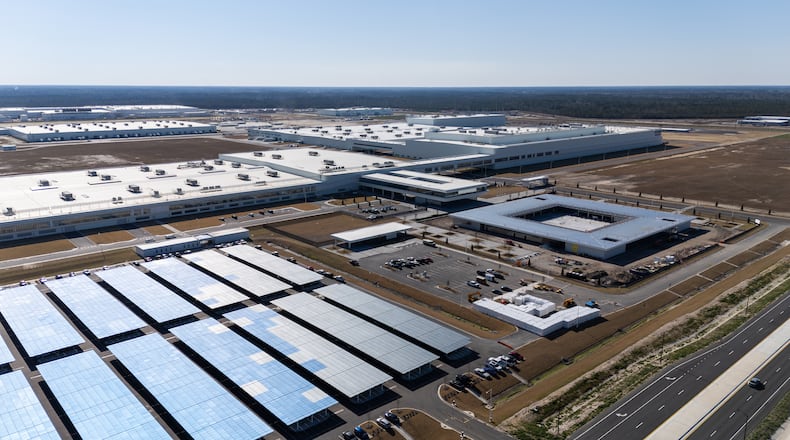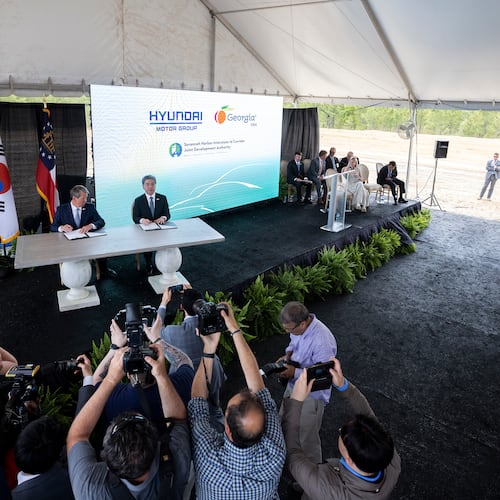The Hyundai brand logo, a stylized H slanting to the right, is meant to symbolize forward motion.
When it comes to the South Korean automaker’s electric vehicle assembly factory near Savannah, the H logo might as well feature racing stripes. Officials broke ground on the 16 million-square-foot facility in October 2022 and launched full production two years later during the first week of October 2024.
Test production began in spring 2024 as assembly line staffing levels reached enough for one shift. With a stated goal of introducing 23 new EV models and manufacturing 1.44 million battery-powered cars annually by 2030, Hyundai’s sense of urgency in opening the Georgia plant reflects the automakers’ view of “the future of mobility,” officials said.
Or as Carter Infinger, an elected leader in Bryan County where the plant was built, said, “Our friends from Korea only know one speed: Full throttle.”
Here’s what you need to know about the manufacturing facility, which Hyundai calls the Metaplant.
Credit: Photo courtesy of HMGNA
Credit: Photo courtesy of HMGNA
What’s the 411 on the assembly plant?
Hyundai is investing $7.6 billion on a 2,906-acre site. The assembly facility is designed to produce up to 500,000 vehicles per year, a number revised upwards in March 2025 from 300,000. An EV battery manufacturing plant and a worker training center are under construction on the site and are scheduled to open in 2026. All together, the project is the largest in Georgia economic development history.
The property sits along I-16 behind a truck weigh station near the small town of Ellabell, about 25 miles west of downtown Savannah. A highway interchange is located just west of the site and another exit is planned immediately to the east of the plant, with a projected opening date in 2027.
Formerly known as the Bryan County Megasite, the Hyundai property was first readied for development a decade ago when Volvo considered opening a factory in the Savannah area. The state of Georgia expanded the size of the site in 2021 after selling part of another Savannah industrial parcel to Amazon.
Hyundai inquired about the property in January 2022 and within five months announced plans to build the factory in Georgia. Site preparation began that August and vertical construction started in early 2023.
What cars does Hyundai make in Georgia?
The plant launched with the IONIQ 5, Hyundai’s best-selling EV model. An SUV, the IONIQ 9, was added months later. The assembly facility is designed for flexibility, with vehicles moving through the factory on self-propelled dollies that also deliver parts. Several thousand robots perform tasks alongside workers, whom Hyundai calls metapros. This approach is meant to allow for the production of more than one vehicle model on the same assembly line.
Officials for the automaker have said the plant will manufacture vehicles for all three of its brands: Hyundai, Kia and Genesis. Hyundai already operates two factories in the region, producing Hyundais in Montgomery, Ala., and Kias in West Point. The Kia plant recently began production of an EV, the Kia EV9.
The Savannah facility will produce hybrid and plug-in hybrid cars in addition to EVs beginning in 2026. Hybrids are propelled by electric batteries that are charged while in motion by a traditional gasoline-powered motor, resulting in greater fuel efficiency.
As much as one-third of the vehicles produced at the factory will be hybrids.
The onsite battery manufacturing facility is meant to shorten the supply chain. Hyundai is building a second battery factory near Cartersville.
What about the workforce?
Hyundai agreed to employ 8,500 workers at the Savannah manufacturing campus, including 2,600 in the assembly plant, as part of a $2.1 billion incentives package struck with state and local officials. The battery plant near Cartersville will hire 3,500 more.
The automaker began hiring within months of announcing the project. As of September 2025, the assembly plant and its subsidiaries on the megasite employ 2,507 workers. At the assembly facility, more than 70% of the hires live within 60 miles of the factory site despite a historically low unemployment rate around 3% for the Savannah metro area as reported by the Georgia Department of Labor.
Credit: Bloomberg
Credit: Bloomberg
A study commissioned by Savannah Economic Development Authority, or SEDA, projects the local metro area need to add 24,000 people to its workforce between 2024 and 2030. The region’s labor pool grew by nearly 3,000 workers between July 2023 and June 2025. The Savannah Economic Development Authority, or SEDA, created a regional workforce coalition, named RISE, in December 2023 to address local labor market issues.
Hyundai is training workers through Georgia Quick Start, a state program specializing in advanced manufacturing, as well as through coastal Georgia technical colleges such as Savannah Tech and Ogeechee Tech in Statesboro. Quick Start operates a training center in the Savannah suburb of Pooler and has leased additional space to handle Hyundai hires.
What about suppliers?
Hyundai’s supplier network will touch many parts of southeast Georgia as well as other areas of the state, including metro Atlanta. Currently, 20 suppliers manufacturing everything from seats to climate control parts have been announced, with 14 of those located near the metaplant.
Together, those firms are projected to employ more than 7,000 workers and invest $2.5 billion in new facilities.
Credit: © Karine Aigner
Credit: © Karine Aigner
What else is there to know?
Hyundai rushed to open the Savannah factory campus even as EV sales underperformed to expectations in part because of restrictions to federal EV incentives. Only EVs manufactured in the United States qualify for the $7,500 purchase rebate, although there is a loophole for leased vehicles. The EV models manufactured in Georgia became eligible for the incentives in April 2025 when Hyundai began sourcing EV batteries from a factory in Commerce, Georgia.
The Georgia-made Hyundais are meant for domestic sale and not for export. This means the Georgia Ports Authority’s auto terminal in Brunswick, the busiest in the country, is not expecting to see a Hyundai-related increase in business from Hyundai. GPA is handling imports of parts and materials for the Hyundai plant through its Savannah terminals.
Hyundai’s time at the Bryan County site has been marked by tragedy and controversy. Three construction workers have died on the property, the most recent in May 2025 at the EV battery factory operated by HL-GA Battery Company, a joint venture of Hyundai and LG Energy Solution, another South Korea-based company.
The other fatality came in April 2023 when a workman, Victor Gamboa, fell from a structure under construction at the site. He was wearing fall protection gear but his safety line sheared on the edge of a steel beam, resulting in him falling 60 feet to his death. The contractor that employed Gamboa, Eastern Constructors Inc., was cited for providing worn, damaged and inadequate safety gear by the Occupational Safety and Health Administration, which investigated the accident.
The Hyundai Metaplant campus was also the site of an immigration raid by federal authorities in September 2025. Immigration and Customs Enforcement detained about 475 workers, including 316 Koreans, and accused them of being in the country illegally or without the proper work permits. The Korean detainees, said to be technicians and specialists brought to the U.S. to set up machinery, were repatriated and flown home a week after the raid.
The incident will push back the opening of the battery plant by two to three months, according to Hyundai. The factory was to open in early 2026.
Other issues plaguing the project involve freshwater and wastewater. The facility is projected to use as much as 4 million gallons of water daily once fully operational, and a plan to pull supply from wells to be built in a neighboring county met heavy public opposition. The Georgia General Assembly in January 2025 passed a budget that includes about $500 million to expand a regional water system that will pull from the Savannah River and supply the Hyundai site, allowing for a reduction in pumping from the controversial wells once the project is completed in 2030.
As for wastewater, Hyundai has been trucking its sewage off-site since September 2024 because it contains high levels of heavy metals. Hyundai has blamed pipes at the site and is replacing the infrastructure but the process won’t be completed until late 2025. In the meantime, the company is trucking the wastewater to privately owned treatment facilities outside the Savannah region.
The manufacturing facility’s construction also displaced residents: gopher tortoises. More than 100 of the reptiles were relocated to Fort Stewart, a sprawling U.S. Army base located 30 miles south of the plant.
About the Author
Keep Reading
The Latest
Featured





